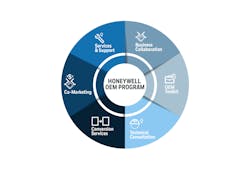How to improve OEM profitability by gaining an edge in technology and service
The original equipment manufacturer (OEM) has a unique set of technology needs and staffing requirements that continue to become more challenging as automation becomes more ubiquitous in the industrial factory. Where can an OEM turn for help in addressing these challenges?
Swapnil Adkar, senior market development manager, global OEMs, at Honeywell, answers several questions about technology and staffing that address these issues.
SWAPNIL ADKAR
Senior Market Development Manager, Global OEMs
Honeywell
Q: How does Honeywell help to improve operating efficiency for OEMs?
A: We launched the OEM Program last year with a focus on simplifying day-to-day operations for OEM engineering and purchase teams. Equipment-specific engineering toolkits that can be developed as part of the program help to standardize the engineering drawings, project documentation, applications and HMI graphics for equipment, which saves time on repetitive tasks. Honeywell’s robust portfolio, when adopted or standardized for equipment, can help OEMs to reduce the number of suppliers and purchase efforts. This allows OEM staff to focus on other important areas of business.
Q: How does Honeywell’s solution help OEMs to differentiate their offering?
A: Honeywell has been investing in new technologies, such as cybersecurity and competency management through AR/VR applications, Industry 4.0 open protocols, universal I/O technology or cloud-based instrumentation configuration tools and more. These new product developments are aimed at solving OEM’s toughest challenges, such as fast delivery, early startups or flexibility in last-minute changes to engineering. We strive to identify the unmet needs of OEMs and create a differentiated offering combined with close engagement with them during the product-development process. OEMs find their operating costs and cost of services reduced as they can contact a single vendor for support requirements on Instrumentation, PLCs, Safety systems or HMIs. Our global service organization provides peace of mind to OEMs as we can support their equipment delivery internationally.
Q: What steps or actions are you taking to bridge the skills gap for OEMs?
A: We have been working with OEMs for more than three decades. Domain expertise is important to design, operate and maintain OEM assets. With an ageing workforce, this is emerging as a challenge globally. Our technology helps OEMs to create AR/VR-based training modules to instruct their new workforces. We also conduct product training sessions throughout the year to help engineering and services teams to learn about the latest product updates. Also, we are known for strong execution expertise on automation projects, and OEMs can leverage this expertise for engineering, integration and commissioning efforts for instrumentation, control and safety systems.
The Honeywell OEM program offers six distinct program components that work together for a holistic approach to efficiency.
Q: Can you talk about the objective behind Honeywell’s OEM program?
A: We have teamed up with several OEMs and have learned that structured engagement models and ecosystems of tools and support mechanisms will help OEMs to improve operating efficiency. Also, another important topic that was raised is the need for a committed automation partner for custom solution development or during their R&D and standardization activities. Our objective here is to serve OEMs with strong technical support and differentiated offerings to develop long-term engagement. This program also allows OEMs to leverage Honeywell’s strong brand presence to promote the equipment integrated with our state-of-the-art technology.
Q: How does the standardization of package OEM automation help end users?
A: End users are focused on adoption of technology on packaged equipment that supports their plants’ strategies. These include technologies such as digitization, flawless startup with easy integration of systems, as well as cybersecurity capabilities. These factors are critical to their selection criteria for package equipment more than before. Our OEMs have benefitted from the ability of our SmartLine® transmitter family to perform auto device commissioning with our DCS as well as seamless integration of our ControlEdge™ PLCs with a distributed control system (DCS) at site. IIoT protocol support on PLCs enables easy data collection on cloud or centrally hosted systems to support digitization and asset analytics. Embedded cybersecurity compliant with ISA standards on our PLC, RTU and DCS controllers helps end users and OEMs to mitigate cybersecurity risk and comply with regulations.
Q: How does this program help to reduce the OEM’s risk in adoption of new technology?
A: As a part of the program conversion services, our engineering team works jointly with the OEM’s engineering team to seamlessly switch to Honeywell technology. A very structured approach is followed where we conduct proof of concept (POC) with new technologies to make sure key requirements of the OEM are fulfilled. Our execution expertise ensures POCs are managed professionally and our engineers and project managers ensure we address key risk elements during functional testing in sandbox for a new solution.
Q: What is Honeywell doing to improve the OEM's experience in solution development?
A: Coming up with a differentiated technical solution is a common challenge for OEMs as technology evolves fast and end-user demands change. A trusted technology partner that provides an edge due to fast response time to customer requirements will result in improved competitiveness. We have a global team of technical consultants who work with OEMs to understand their requirements and help to develop a solution meeting their needs and come up with a differentiated solution. They also conduct training sessions for OEM engineering teams to upskill them for new solutions and high-quality deliveries.



